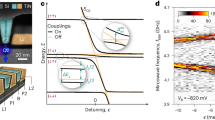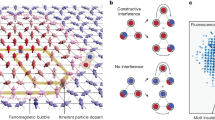Abstract
Electron spin resonance (ESR) spectroscopy is a crucial tool, through spin labelling, in investigations of the chemical structure of materials and of the electronic structure of materials associated with unpaired spins. ESR spectra measured in molecular systems, however, are established on large ensembles of spins and usually require a complicated structural analysis. Recently, the combination of scanning tunnelling microscopy with ESR has proved to be a powerful tool to image and coherently control individual atomic spins on surfaces. Here we extend this technique to single coordination complexes—iron phthalocyanines (FePc)—and investigate the magnetic interactions between their molecular spin with either another molecular spin (in FePc–FePc dimers) or an atomic spin (in FePc–Ti pairs). We show that the molecular spin density of FePc is both localized at the central Fe atom and also distributed to the ligands (Pc), which yields a strongly molecular-geometry-dependent exchange coupling.

This is a preview of subscription content, access via your institution
Access options
Access Nature and 54 other Nature Portfolio journals
Get Nature+, our best-value online-access subscription
$29.99 / 30 days
cancel any time
Subscribe to this journal
Receive 12 print issues and online access
$259.00 per year
only $21.58 per issue
Buy this article
- Purchase on Springer Link
- Instant access to full article PDF
Prices may be subject to local taxes which are calculated during checkout





Similar content being viewed by others
Data availability
All the data that support the findings of this study are available in this article and its Supplementary Information, or from the corresponding authors on reasonable request. The source data and DFT models that support all the figures displayed in the main article and Supplementary Information are also publicly available through the link https://doi.org/10.6084/m9.figshare.16574534.v137.
Code availability
The MATLAB code used to plot and fit the ESR spectra displayed in article and Supplementary Information is available through the Figshare link, https://doi.org/10.6084/m9.figshare.16574534.v137. WSxM software39 was used to change the colour schemes of our STM images for better clarity; we used the integrated low-order Gaussian filtering function, a built-in function within the software, without modifications.
References
Atzori, M. & Sessoli, R. The second quantum revolution: role and challenges of molecular chemistry. J. Am. Chem. Soc. 141, 11339–11352 (2019).
Wrachtrup, J., von Borczyskowski, C., Bernard, J., Orrit, M. & Brown, R. Optical detection of magnetic resonance in a single molecule. Nature 363, 244–245 (1993).
Köhler, J. et al. Magnetic resonance of a single molecular spin. Nature 363, 242–244 (1993).
Bayliss, S. L. et al. Optically addressable molecular spins for quantum information processing. Science 370, 1309–1312 (2020).
Rugar, D., Budakian, R., Mamin, H. J. & Chui, B. W. Single spin detection by magnetic resonance force microscopy. Nature 430, 329–332 (2004).
Lovchinsky, I. et al. Nuclear magnetic resonance detection and spectroscopy of single proteins using quantum logic. Science 351, 836–841 (2016).
Gehring, P., Thijssen, J. M. & van der Zant, H. S. J. Single-molecule quantum-transport phenomena in break junctions. Nat. Rev. Phys. 1, 381–396 (2019).
Vincent, R., Klyatskaya, S., Ruben, M., Wernsdorfer, W. & Balestro, F. Electronic read-out of a single nuclear spin using a molecular spin transistor. Nature 488, 357–360 (2012).
Thiele, S. et al. Electrically driven nuclear spin resonance in single-molecule magnets. Science 344, 1135–1138 (2014).
Tesi, L. et al. Quantum coherence in a processable vanadyl complex: new tools for the search of molecular spin qubits. Chem. Sci. 7, 2074–2083 (2016).
Graham, M. J. et al. Influence of electronic spin and spin–orbit coupling on decoherence in mononuclear transition metal complexes. J. Am. Chem. Soc. 136, 7623–7626 (2014).
Seifert, T. S. et al. Single-atom electron paramagnetic resonance in a scanning tunneling microscope driven by a radio-frequency antenna at 4 K. Phys. Rev. Res. 2, 013032 (2020).
Natterer, F. D. et al. Upgrade of a low-temperature scanning tunneling microscope for electron-spin resonance. Rev. Sci. Instrum. 90, 013706 (2019).
Baumann, S. et al. Electron paramagnetic resonance of individual atoms on a surface. Science 350, 417–420 (2015).
Willke, P. et al. Hyperfine interaction of individual atoms on a surface. Science 362, 336–339 (2018).
Yang, K. et al. Electrically controlled nuclear polarization of individual atoms. Nat. Nanotechnol. 13, 1120–1125 (2018).
Durkan, C. & Welland, M. E. Electronic spin detection in molecules using scanning-tunneling-microscopy-assisted electron-spin resonance. Appl. Phys. Lett. 80, 458–460 (2002).
Hiraoka, R. et al. Single-molecule quantum dot as a Kondo simulator. Nat. Commun. 8, 16012 (2017).
Mugarza, A. et al. Electronic and magnetic properties of molecule–metal interfaces: transition-metal phthalocyanines adsorbed on Ag(100). Phys. Rev. B 85, 155437 (2012).
Yang, K. et al. Tunable giant magnetoresistance in a single-molecule junction. Nat. Commun. 10, 3599 (2019).
Bogani, L. & Wernsdorfer, W. Molecular spintronics using single-molecule magnets. Nat. Mater. 7, 179–186 (2008).
Bae, Y. et al. Enhanced quantum coherence in exchange coupled spins via singlet-triplet transitions. Sci. Adv. 4, eaau4159 (2018).
Willke, P., Yang, K., Bae, Y., Heinrich, A. J. & Lutz, C. P. Magnetic resonance imaging of single atoms on a surface. Nat. Phys. 15, 1005–1010 (2019).
Tsukahara, N. et al. Adsorption-induced switching of magnetic anisotropy in a single iron(II) phthalocyanine molecule on an oxidized Cu(110) surface. Phys. Rev. Lett. 102, 167203 (2009).
Abragam, A. & Bleaney, B. Electron Paramagnetic Resonance of Transition Ions (Oxford Univ. Press, 2012).
Yang, K. et al. Tuning the exchange bias on a single atom from 1 mT to 10 T. Phys. Rev. Lett. 122, 227203 (2019).
Yan, S., Choi, D.-J., Burgess, J. A. J., Rolf-Pissarczyk, S. & Loth, S. Control of quantum magnets by atomic exchange bias. Nat. Nanotechnol. 10, 40–45 (2015).
Assour, J. M. & Kahn, W. K. Electron spin resonance of α- and β-cobalt phthalocyanine. J. Am. Chem. Soc. 87, 207–212 (1965).
Konarev, D. V. et al. Ionic compound containing iron phthalocyanine (FeIPc)− anions and (C70−)2 dimers. Optical and magnetic properties of (FeIPc)− in the solid state. Dalton Trans. 41, 13841–13847 (2012).
Wolf, E. L. & Losee, D. L. G-shifts in the ‘s-d’ exchange theory of zero-bias tunneling anomalies. Phys. Lett. A 29, 334–335 (1969)
Barnes, S. E. Theory of electron spin resonance of magnetic ions in metals. Adv. Phys. 30, 801–938 (1981).
Yang, K. et al. Engineering the eigenstates of coupled spin-1/2 atoms on a surface. Phys. Rev. Lett. 119, 227206 (2017).
Choi, T. et al. Atomic-scale sensing of the magnetic dipolar field from single atoms. Nat. Nanotechnol. 12, 420–424 (2017).
Noodleman, L. Valence bond description of antiferromagnetic coupling in transition metal dimers. J. Chem. Phys. 74, 5737–5743 (1981).
Czap, G. et al. Probing and imaging spin interactions with a magnetic single-molecule sensor. Science 364, 670–673 (2019).
Ferrando-Soria, J. et al. A modular design of molecular qubits to implement universal quantum gates. Nat. Commun. 7, 11377 (2016).
Zhang, X. et al. Electron spin resonance of single iron-phthalocyanine molecules and role of their non-localized spins in magnetic interaction (source data, codes and raw images). Figshare https://doi.org/10.6084/m9.figshare.16574534.v1 (2021).
Paul, W. et al. Control of the millisecond spin lifetime of an electrically probed atom. Nat. Phys. 13, 403–407 (2017).
Horcas, I. et al. WSXM: a software for scanning probe microscopy and a tool for nanotechnology. Rev. Sci. Instrum. 78, 013705 (2007).
Giannozzi, P. et al. QUANTUM ESPRESSO: a modular and open-source software project for quantum simulations of materials. J. Phys. Condens. Matter 21, 395502 (2009).
Giannozzi, P. et al. Advanced capabilities for materials modelling with Quantum ESPRESSO. J. Phys. Condens. Matter 29, 465901 (2017).
Prandini, G., Marrazzo, A., Castelli, I. E., Mounet, N. & Marzari, N. Precision and efficiency in solid-state pseudopotential calculations. npj Comput. Mater. 4, 1–17 (2018).
Perdew, J. P., Burke, K. & Ernzerhof, M. Generalized gradient approximation made simple. Phys. Rev. Lett. 77, 3865–3868 (1996).
Grimme, S., Hansen, A., Brandenburg, J. G. & Bannwarth, C. Dispersion-corrected mean-field electronic structure methods. Chem. Rev. 116, 5105–5154 (2016).
Acknowledgements
All the authors acknowledge support from the Institute for Basic Science under grant IBS-R027-D1. P.W. also acknowledges funding from the Emmy Noether Programme of the DFG (WI5486/1-1). We thank N. Lorente for fruitful discussions.
Author information
Authors and Affiliations
Contributions
T.C. and X.Z. designed the project. X.Z., Y.W., T.B. and P.W. performed the experiments. C.W. carried out the DFT calculations. H.A. contributed to the Hamiltonian model simulations. X.Z. and T.C. wrote the manuscript with the help of all the authors. T.C. and A.J.H. advised the project process.
Corresponding authors
Ethics declarations
Competing interests
The authors declare no competing interests.
Additional information
Peer review information Nature Chemistry thanks the anonymous reviewers for their contribution to the peer review of this work.
Publisher’s note Springer Nature remains neutral with regard to jurisdictional claims in published maps and institutional affiliations.
Supplementary information
Supplementary Information
Supplementary Sections 1–19: STM images, STM spectroscopic measurements, ESR spectra and DFT studies, additional discussion, Figs. 1–25, Tables 1–3 and references
Supplementary Data 1
All related DFT computational models used in the main article and Supplementary Information are supplied in a Supplementary zip file. Once unzipped, the name of each file indicates its content.
Rights and permissions
About this article
Cite this article
Zhang, X., Wolf, C., Wang, Y. et al. Electron spin resonance of single iron phthalocyanine molecules and role of their non-localized spins in magnetic interactions. Nat. Chem. 14, 59–65 (2022). https://doi.org/10.1038/s41557-021-00827-7
Received:
Accepted:
Published:
Issue Date:
DOI: https://doi.org/10.1038/s41557-021-00827-7
This article is cited by
-
Challenges for exploiting nanomagnet properties on surfaces
Communications Chemistry (2024)
-
Regulation of quantum spin conversions in a single molecular radical
Nature Nanotechnology (2024)
-
Triplet-mediated spin entanglement between organic radicals: integrating first principles and open-quantum-system simulations
NPG Asia Materials (2023)
-
Universal quantum control of an atomic spin qubit on a surface
npj Quantum Information (2023)
-
Autonomous scanning probe microscopy investigations over WS2 and Au{111}
npj Computational Materials (2022)



